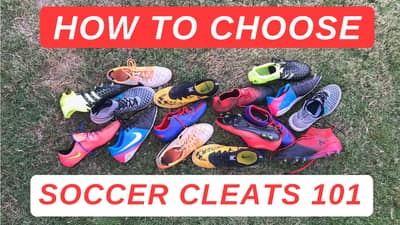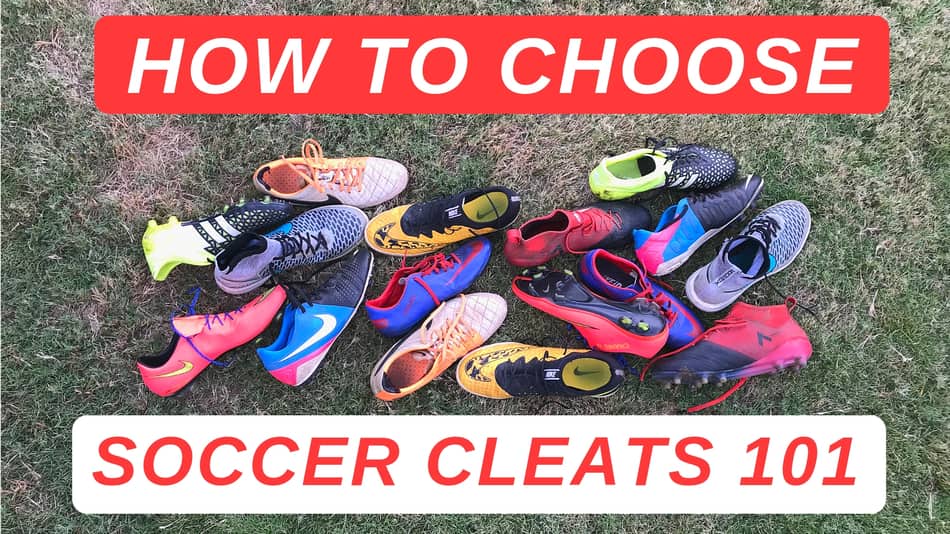
Every time I am going to buy a new pair of soccer cleats I have a very bad time. The soccer gear world is super tricky and there a lot of things you need to know in order to buy the best soccer cleats for you. If you don’t know the information I will tell you in this article, there are is a great chance things can go wrong in this process of buying football boots for you.
The process of buying the perfect soccer cleats for you looks like this:
- Step 1: Make your research
- Step 2: Choose playing surface
- Step 3: What type of feel do you want?
- Step 4: Choosing the upper
- Step 5: What is your budget?
Even though choosing soccer cleats is hard, it is also super fun. The steps I mentioned above have helped me tremendously when I buy soccer cleats. However, there are a lot of misconceptions in this football boot world we’ll be breaking down in this article. This is soccer cleats 101, and after you read this you’ll be closer to being an expert in this topic.
Choosing Soccer Cleats/Football boots

The first and most important thing you need to know is that there is nothing like “The Best Soccer Cleat in the Market”. It’s impossible to tell which one is the best because each soccer player has different preferences regarding to feel, upper, stud pattern, etc. So, in these article the idea is to help you find the soccer cleat that works best for you and satisfies your necessities completely.
Being that said, if you’re curious to know what is my personal favorite soccer cleat, and the one I would choose to play a game at this moment, you can see it by clicking here: “My recommended soccer cleats/Football boots”. I’m confident this is a type of soccer cleat that will satisfy most players and that most people will be happy to wear. With that being said, it can also not be the best soccer cleat for you.
With every pair of soccer cleats you buy, you should also buy a great pair of grip socks. Grip Socks help get the most out of every soccer cleats by improving the fit of the shoes and reducing foot slippage inside the boots. In my recommended Grip Socks page you’ll see what for me are the best grip socks to use with any soccer cleats.
Another thing I would like to mention, is that you need to take into consideration that most people are buying soccer gear online. In my specific case, I do it because where I live they don’t sell the best soccer gear out there. Also, there will be some cases where you’ll have to buy online because the product doesn’t exist physically near you. Make sure to only buy at well-recognized online stores to stay away from any type of scam.
Step 1: Making Your Research
I’m sure that 70% of the times you are going to buy a pair of football boots you already have an idea of two or three cleats that call your attention. We live in an era where there is endless information about absolutely everything in the internet, and soccer cleats are not the exception.
I’m sure that there are hundreds of reviews online on every soccer cleat that you might think of. Specially if you’re buying online, this is a super important step because you need to learn the most about the boot you are going to buy; obviously you can’t touch the boot physically until you buy it.
This is not a problem at all. There are people who actually own the boot that will make detailed reviews of each one of them online. Try looking at everything you can: Unboxings of the cleats so you know what comes in the box when you buy them, reviews made by people in youtube or in google. Again, there is plenty of information online, an advantage some years back football boot buyers didn’t have.
Another important reason you need to make research is because of sizing. There are soccer cleats that won’t run true to size. When you buy at a store you can try them on before buying, but online you can’t. In your research you need to make sure if they run true to size, a size small, or a size big. However, online stores have introduced many tools to measure your feet, and to make sure that cleats fit you properly, so this physical barriers are becoming smaller everyday.
The idea is that you can make the best mental image possible of what it is having the cleats, so that when they arrive you won’t have any surprises. A mistake I made is that I only looked at the good things the pair of soccer cleats I wanted. You need to also look at the bad things people who own the cleats say they have.
What to do if you have no idea what soccer cleat to buy
What I do when I have absolutely no idea what football boot to buy is that I go to the biggest soccer gear stores in the internet and just take a look on what they have on offer. I will see what boots call my attention at first sight, and I would choose 3 or 4 pairs that I think fit me best. After that I will research each one and see which one I like the most. For me the best online soccer stores and the ones I trust the most are: Soccer.com and Unisportstore.com.
Step 2: Choosing the Playing Surface
This is easily the most basic and fundamental step when buying soccer cleats. You need to get this right, otherwise you might end up choosing the wrong pair of cleats for the surface that you are playing at, which can result in a terrible, nasty injury. Also, you might be playing in disadvantage in comparison to other players that have the correct pair of cleats.
There are 5 types of playing surfaces in soccer, which means there are also 5 different outsoles to choose from:
- Firm Ground
- Soft Ground
- Artificial Grass
- Turf
- Indoor
I will talk about each one of them and show you some pictures of what each surface looks like. Also, it is important that you know which pair you should use in each one and what outsoles to avoid.
Firm Ground
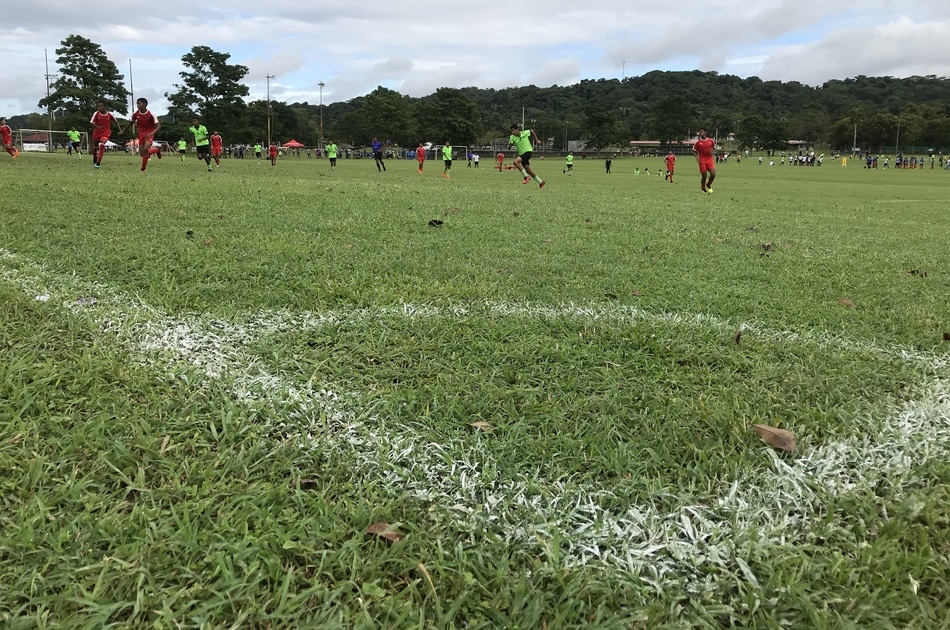
Firm Ground, is a playing surface of natural grass that has a hard firm base as the one you see in the picture. This is a type of playing surface that is not as professional as Soft Ground, which you will see later, but is great to playing soccer anyways. This is easily the most common type of playing surface in soccer and the one most players will be playing at.
The type of outsole you must use in this playing surface is the FG outsole. This type of outsole is so great for this surface because it penetrates the grass enough to give you the right amount of traction you need, but is not as aggressive as the soft ground outsole. Below you can see a picture of an FG soleplate.
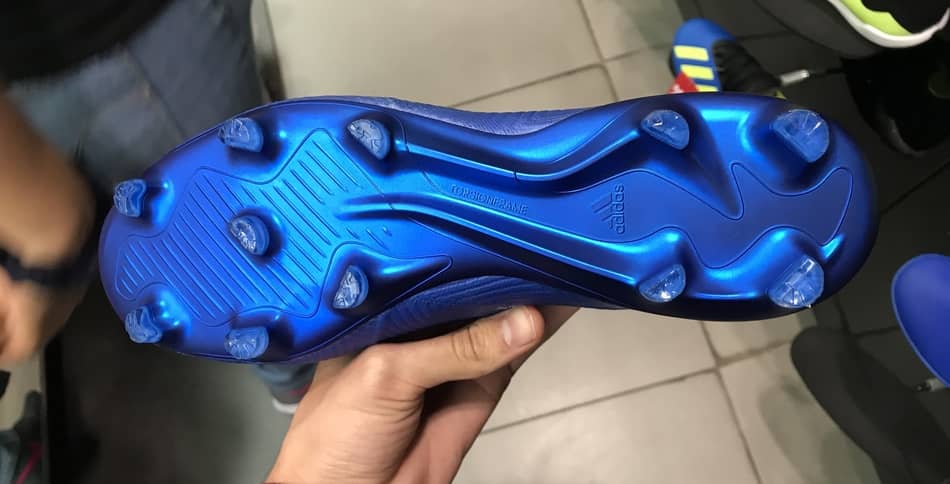
FG outsoles area also the type of outsole that most amateur soccer players will buy and use because it is the one that can be used in most playing surfaces (firm ground and artificial grass). Although, it is recommendable to only wear it in firm ground playing surfaces if possible.
Also, an outsole you should avoid using in this surface is SG. This type of cleat has metal studs that are to aggressive for this surface, which means that you can run the risk of suffering from stud pressure and stress in your lower limb joint (knees, ankles, etc). I would only recommend buying FG soleplate for this surface, a type of boot that you will find everywhere in the world.
Soft Ground
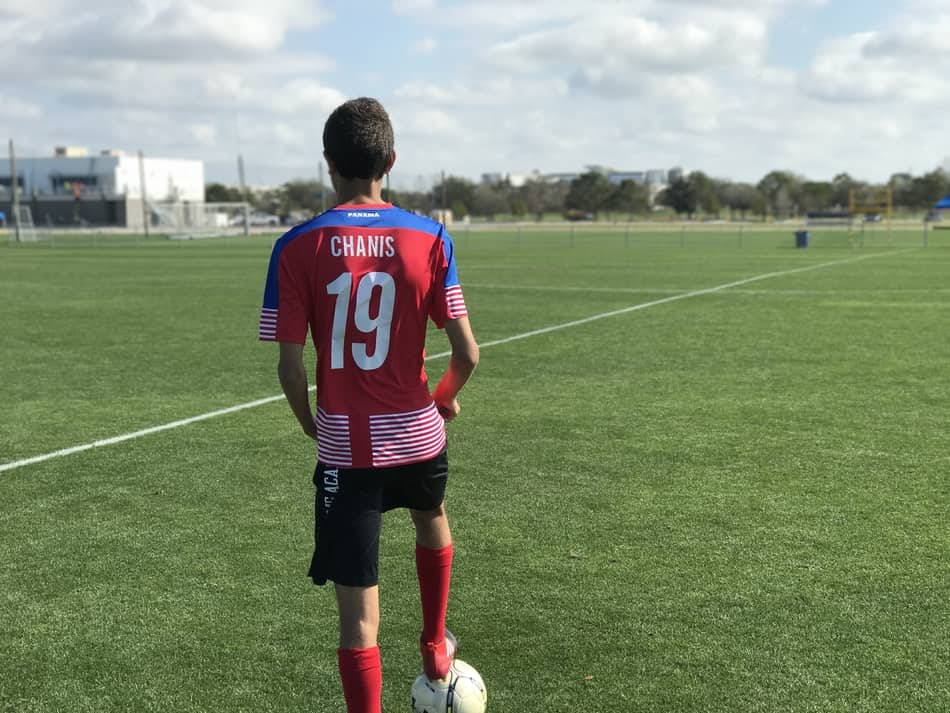
Soft Ground is the best playing surface any soccer player can play at. This are professional soccer fields that are well mowed, watered, and well taken care overall. This surface has a soft, deep base. The grass is cut low (about 2 cm long), but below the grass you can find layers of sand and gravel that provide a cushioned feel when playing in this surface.
Above you can see an image of me playing in soft ground surface in a soccer camp I went in florida. You can see that the grass looks professional and well treated. With that being said, an amateur, regular soccer player rarely gets to play in this surface at a local club. Most of the times when we play on grass it will be firm ground, so don’t get confused.
The correct soccer cleat to buy to play exclusively in this surface is SG soleplate. As you can see in the image below, SG boots have removable screwed-in metal studs that provide a good penetration and traction in this wet playing surface.
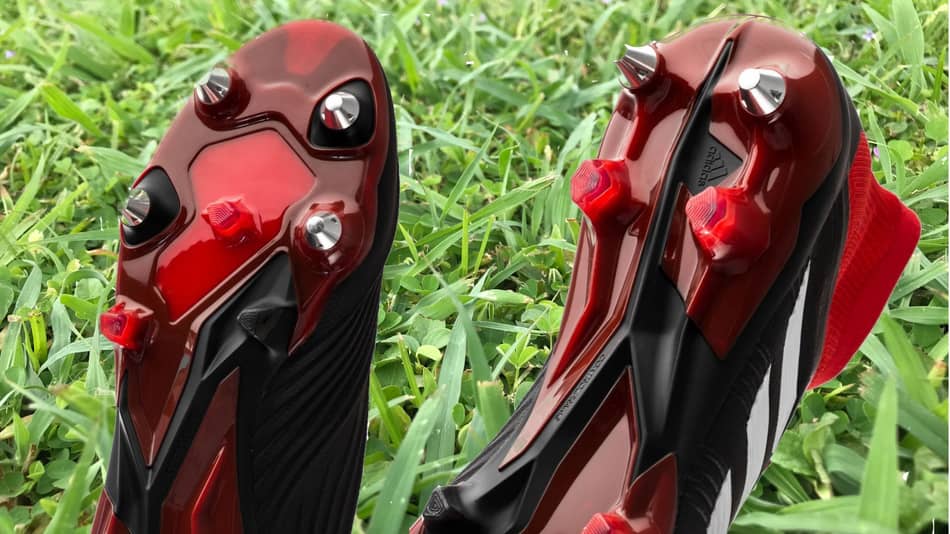
I would recommend that you buy this pair of football boots only if you are playing exclusively in this playing surface. They are dangerous to use in other surfaces, including firm ground. NEVER EVER USE THESE TYPE OF CLEATS TO PLAY IN ARTIFICIAL GRASS OR TURF. If you do it, you’ll probably suffer a horrible injury, and you can also significantly damage the soccer pitch.
If you only play in soft ground once in a while or you are playing in SG as well as FG, just buy a pair of FG boots that will work great on both soft and firm ground playing surfaces.
Artificial Grass
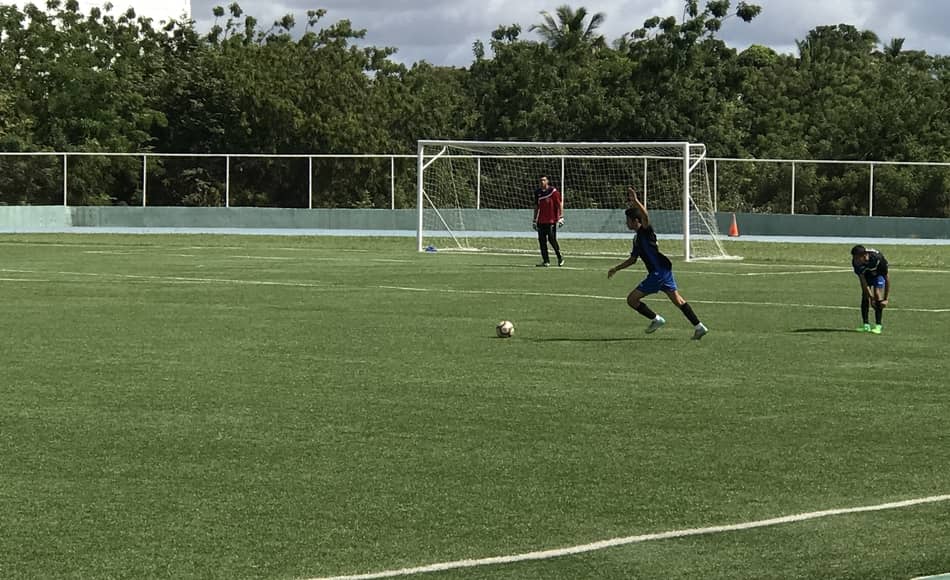
Artificial grass is made out of a synthetic material that simulates natural grass. These artificial grass pitches are built and installed in a specific way, that follows international standards, to mimic the feeling of playing in a natural grass field in the best way possible. According to FIFA, it is allowed to play professional soccer games in this playing surface.
However, not everything is as good as it seems. In my article “The Reason Why all Soccer Players Hate Artificial Grass” I write about all the disadvantages playing in this surface has, and why all professional players prefer to play on grass instead.
Nonetheless, Artificial Grass pitches are becoming more and more common every single day. For this reason, we need to be prepared to buy the correct soccer gear to play in this surface.

Here, you can see a pair of football boots with an AG outsole. This type of outsole is designed to play specifically on artificial grass pitches. AG is so great because it is an outsole with a lot of studs to better distribute the weight along the foot, avoiding stud pressure resulting from playing here.
Also, the studs are rounded and shorter than an FG outsole, which means that they will only sit on top of the surface, without penetrating it, while keeping the amount of traction you need.
In the other hand, if you use FG boots, you might run the risk of these ones penetrating the surface and getting stuck in the pitch, resulting from a very painful injury maybe in your knees or ankle.
However, brands say that you can use FG outsoles on artificial grass. In my opinion if you can get an AG pair would be a lot better. I repeat, for jesus christ, never use SG boots in artificial Grass.
Turf
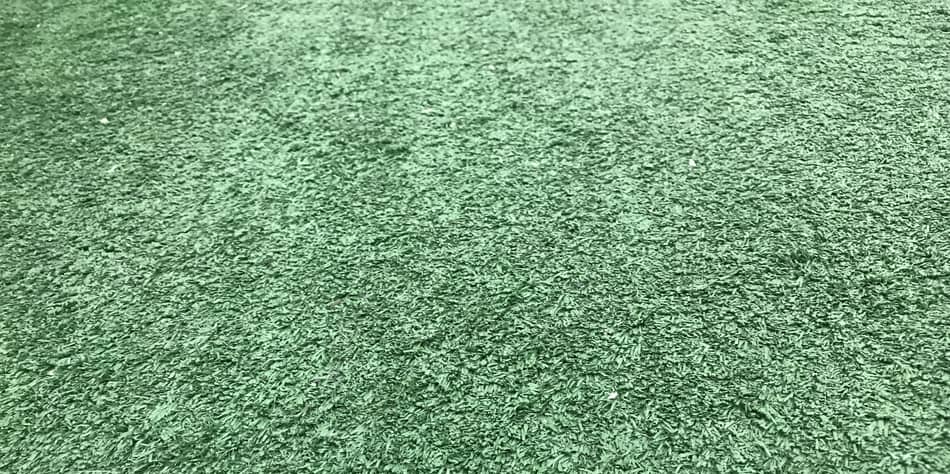
Before you ask the question: “What is the difference between turf and artificial grass?” Aren’t they the same thing? The answer is no, and I explain why in my article that you can read by clicking the link above.
Long story short, there are gigantic differences in terms of quality between one another. In AG it is allowed to play professional games while on turf not. Also, AG follows a maintenance routine and is constantly being modernized, while turf is a surface that is turning obsolete. With that said, there is still many people that play in this surface and are at risk if they dont choose the correct shoes.

Brands make specific outsoles to play on turf as the one in the picture. This outsoles have lots of small rubber studs that give you the traction needed in this surface. It works so well because this is a very shallow surface, that is basically just a carpet on top of cement or sand, making it very hard and rough. The rubber material helps to have a cushioned feel and improves durability in this hard, abrasive playing surface.
I would recommend to only use turf outsoles for this surface. I would totally stay from using AG, FG or SG in this surface. Turf shoes are different from regular soccer cleats/football boots. If you want, you can get advice on how to choose the best for you in my recommend turf shoes page.
Indoor
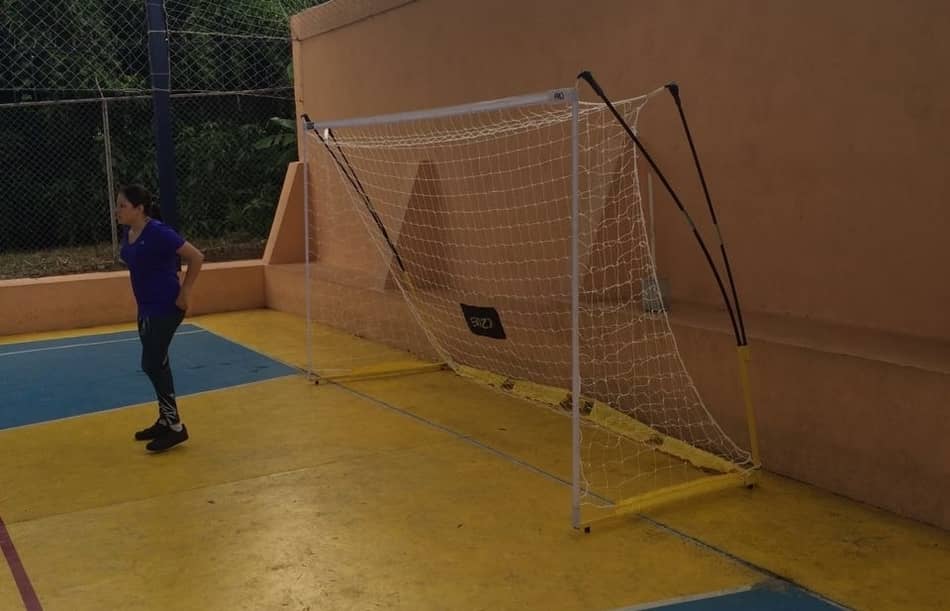
Indoor is a completely different playing surface. In fact, futsal or indoor soccer is a completely different sport from soccer football. Players that play indoor have shoes that are specifically designed for this surface and that you can’t find in FG or SG outsoles.
Indoor soccer is sometimes played in a wooden floor similar to the one in the NBA. Other times, is played in a normal cement floor as the one in the picture. When we talk about indoor soccer we normally also include street soccer in this category (soccer played in concrete). Meaning that a shoe for indoor is also suitable to play in the streets.
In this surface, I would only recommend to use an indoor outsole. Avoid using turf outsoles in this surface too.
Indoor and turf shoes are pretty much the same
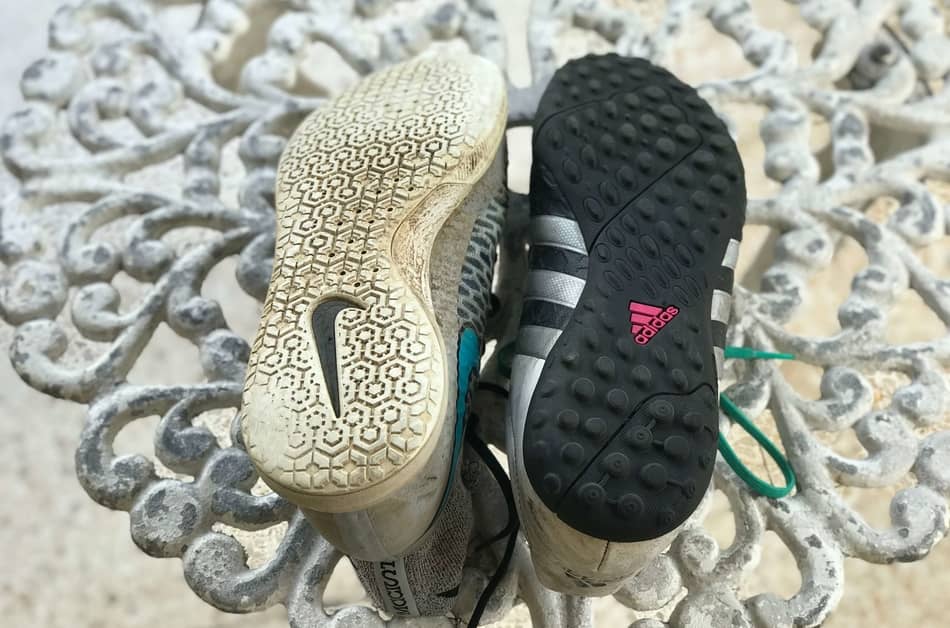
The shoe on the right has an indoor outsole designed to play in the surface I explained above, and the one on the right is designed for a turf surface. The reason I put them together is because brands tend to make unique soccer shoes for this surfaces. Sometimes, this shoes will only be available in a turf and indoor outsole and not in AG, FG or SG.
Other times, big brands like Nike and Adidas make the exact same shoe as the top end cleats used in 11 vs 11 soccer with and indoor and turf outsoles variations for 5 vs 5 soccer. However, when they do this, players that play exclusively in this surface tend to dislike this type of shoes. Which is why we see brands like Joma that are only recognized for their indoor shoes.
Another question people ask and that is a common misconception is: “Can I wear Indoor Soccer shoes on turf?”. They think that buying a pair of indoors will work for them in both surfaces, when this is not the case. Click the link to learn about this topic.
Step 3: What type of feel do you want?
Brands design different soccer cleats/football boots according to the different preferences people have. The feel of a boot is basically the sensation you feel when wearing a pair of soccer cleats. According to my experience, I divided the feels you can get from a cleat in:
- Comfort
- Control
- Speed
- Finishing
We’ll talk about each more in detail and see which one suits you best. This is one of the most important steps to choosing the best soccer cleats for you because it’s where you determine the experience you’ll have with the boot you choose. Keep in mind these are just general guidelines and there might be variations between each feel.
Comfort boots
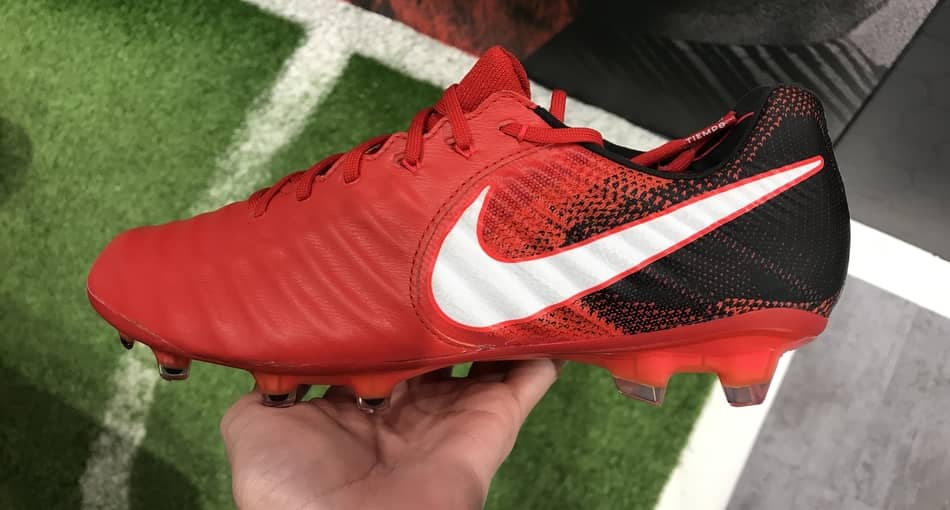
Comfort boots try to keep it simple and as far away from fancy as possible. A comfort boot is a cleat that was specifically designed for those people that like to have a cushioned sensation in their feet. They offer a classic sensation similar to ones we had in older soccer cleats. Great examples of this type of boots are the “Tiempo” and “Copa” lines in Nike and Adidas respectively (Mizuno also offers great quality comfort boots).
Generally, comfort boots are made of a majority leather upper. Also, the stud pattern is not as aggressive as in other types of boots. Normally, with this pair of soccer cleats you will get a stud pattern that consists entirely or mostly of rounded studs that provide great hability to rotate in the spot. Below you can see an image of a stud pattern of an Adidas Copa Mundial.
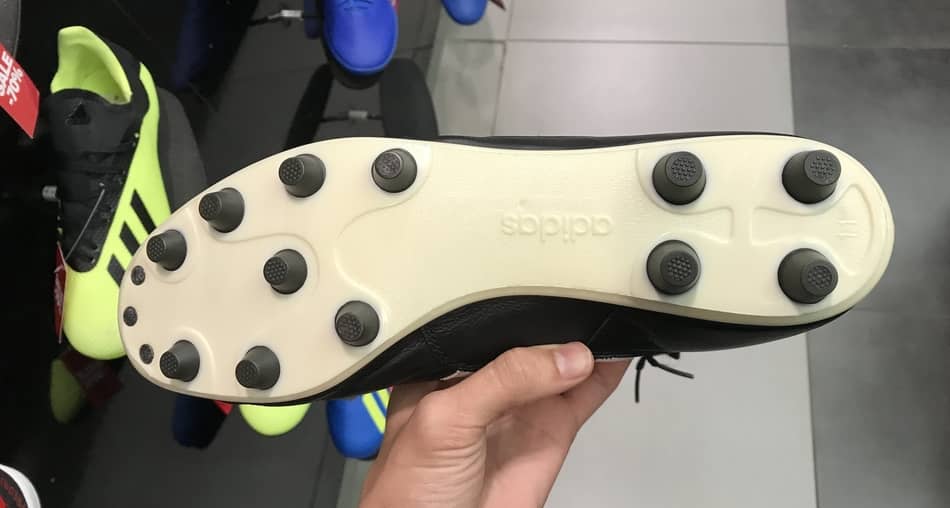
Advantages of comfort cleats:
- Provides a comfort feel.
- Offers a simple and classic feel, while maintaining great quality.
- It’s made of soft leather. This can be an advantage or disadvantage according to your preferences.
- Are generally cheaper than other boots because of the low demand they have (least bought type of cleats).
- Offer great protection.
- Low chances o blisters.
Disadvantages of comfort cleats:
- Are heavier than other soccer cleats.
- Generally, are not visually appealing in the field. Might come in ugly colorways.
- Don’t offer an aggressive stud pattern for a modern game (although there are some exceptions like the “Tiempo” line).
Conclusion: This boot is great for you if you like to keep it simple, prefer classic colors and stud patterns, give priority to your comfort over anything else, and really appreciate good protection in your feet.
Control cleats
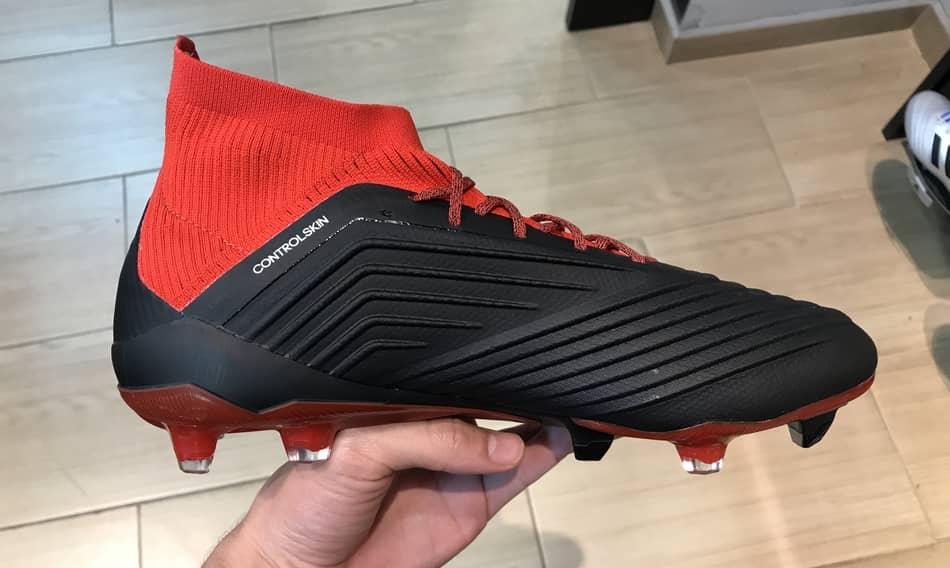
Control boots are soccer cleats that have a lot of control-grippy elements in their surface. One of the most famous control boots of all time are the “Predator” from Adidas. In the image above you can see a pair of these cleats. Normally, control cleats are made by a synthetic upper that is made in a way that makes it as sticky and grippy as possible, even though sometimes we can see control boots made of leather too.
The control boots are made for players that like having the ball close to its feet and appreciate those control elements that give them a cushioned and grip feel with the ball, while maintaining comfort. Their stud pattern can vary a lot, but normally it will consist of a mix of rounded studs, so players can turn and pivot in the spot, and bladed studs to provide great traction when accelerating.
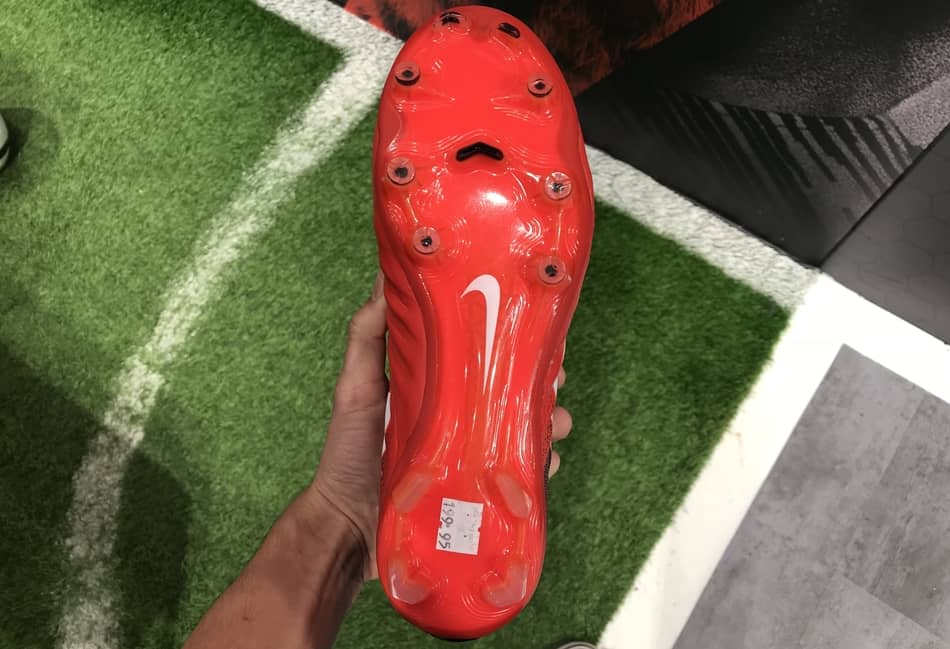
Advantages of control cleats:
- Offers great grip and cushioned sensation with the ball (although might vary).
- Great stud pattern to pivot and make turns while still keeping that “modern soccer cleat” sensation.
- Still very comfortable and pleasant to use.
Disadvantages of control cleats:
- Medium to low protection.
- Sometimes too much grip can be a problem.
- Are slightly heavier than speed and finishing boots.
Conclusion: Is a boot for a player that likes having control grippy elements in the upper, that doesn’t care too much about weight, but that still wants to maintain a certain level of comfort.
Speed boots
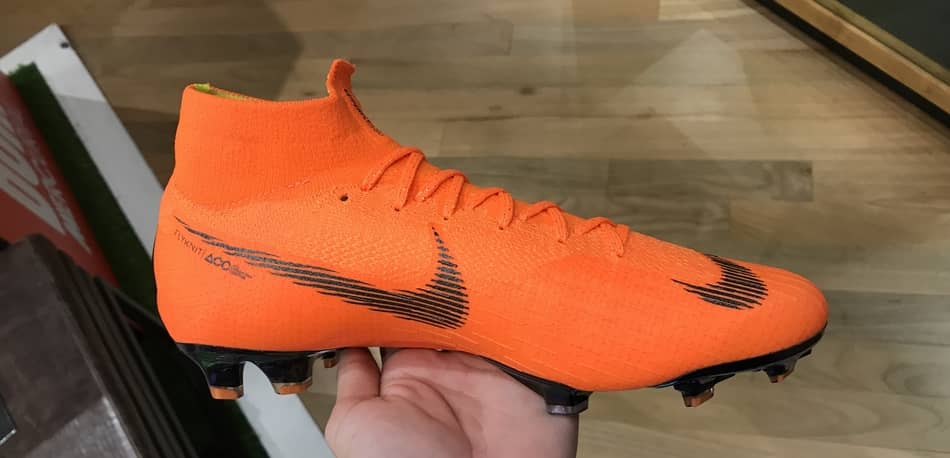
Speed boots are super lightweight soccer cleats, with a thin upper to offer barefoot sensation, and an aggressive stud pattern for quick acceleration and speed. Because the upper is so thin, they offer a barefoot sensation, a feel to the ball similar as playing without choose. This is something many players like.
Speed boots we could say are the “newest” type of soccer cleat out there (although we’ve had some time with them now). The first speed boot I remember in the market were the Nike” Mercurial” line that still exists today. Other historical known brands were the Adidas “F50” line, today known as “X ” line. Other brands like Puma, Mizuno, Umbro, among others.
These are easily the cleats with the greatest demand in the market, the one most young soccer players want for many reasons. One is that it ‘s very visually appealing. They look modern, flashy, and call the attention with their different colorways and silhouettes. Second, is because normally the best forwards in the world use it, and that makes young kids, and even adults, want to buy it too.
Stud pattern usually consists of very aggressive bladed studs, and you’ll rarely see rounded studs in the this soleplates. This outsoles provides huge amounts of traction, perfect for players that like their boots to respond properly when in high speeds.
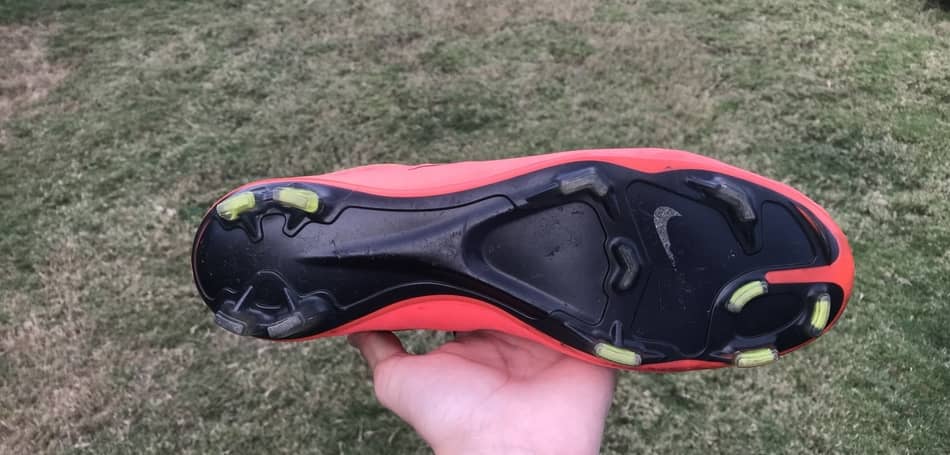
Advantages of speed boots:
- Very lightweight.
- Aggressive traction.
- Barefoot sensation.
Disadvantages of speed boots:
- No protection at all. If you get stepped on, it will hurt… a lot.
- Too aggressive traction for some people. Some might want a more balanced soleplate.
- Levels of comfort are usually lower, but not bad at all.
Conclusion: It is a boot for players that like to have aggressive traction, using very light soccer cleats, and love a barefoot sensation to the ball.
Finishing cleats
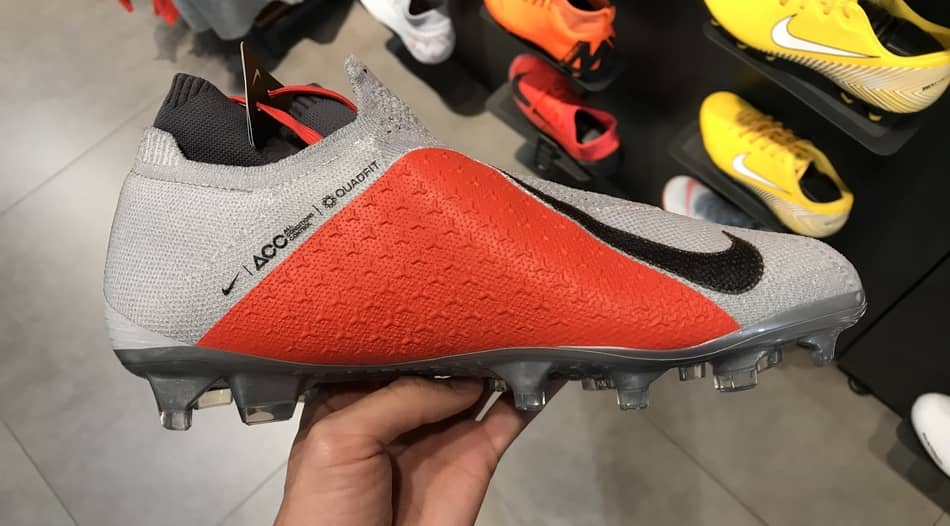
I would also call these cleats “agility boots”. They are the perfect combination between comfort and control elements of the control boots with the aggressiveness of the speed boots. They are characterized for having clean striking elements and zones that provide a grip and cushioned feel when passing and shooting the ball.
The stud pattern is normally made of a mix between both round conical studs and bladed studs. In this way, the boot has a balance between aggressiveness, pivoting and turning. Historically famous models of these type of boots included the old Nike “T90” line, Nike “hypervenom”, the Nike “Phantom Vision” line, old Puma “EvoPower”, and Adidas “Adi pure”.
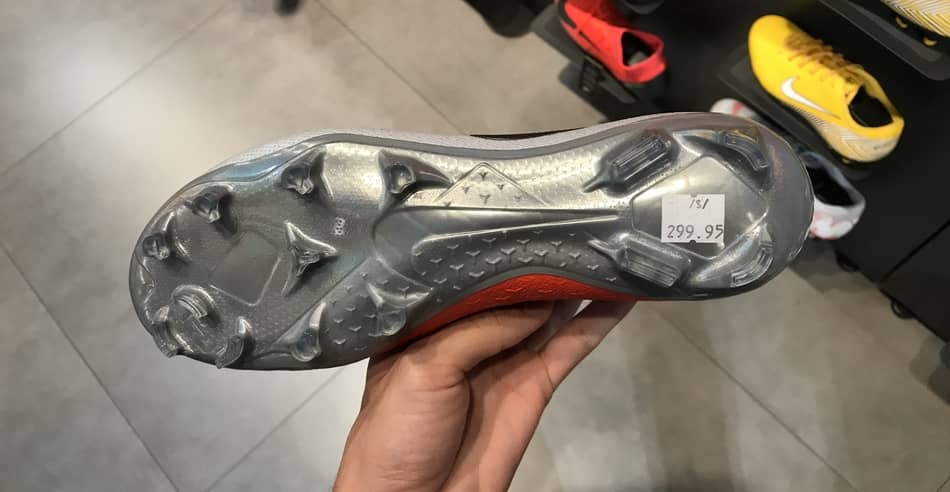
Advantages of Finishing boots:
- Clean striking zones for passing and shooting.
- Relatively lightweight.
- Balanced Stud pattern.
- Usually thin upper.
Disadvantages of Finishing Boots:
- Low protection.
Step 4: Choosing the upper
When we talk about uppers in soccer cleats there are 3 different types:
- Leather
- Synthetic
- Knitted
Each one has different characteristics. You will have to choose which one suits you better and your preferences.
Leather boots
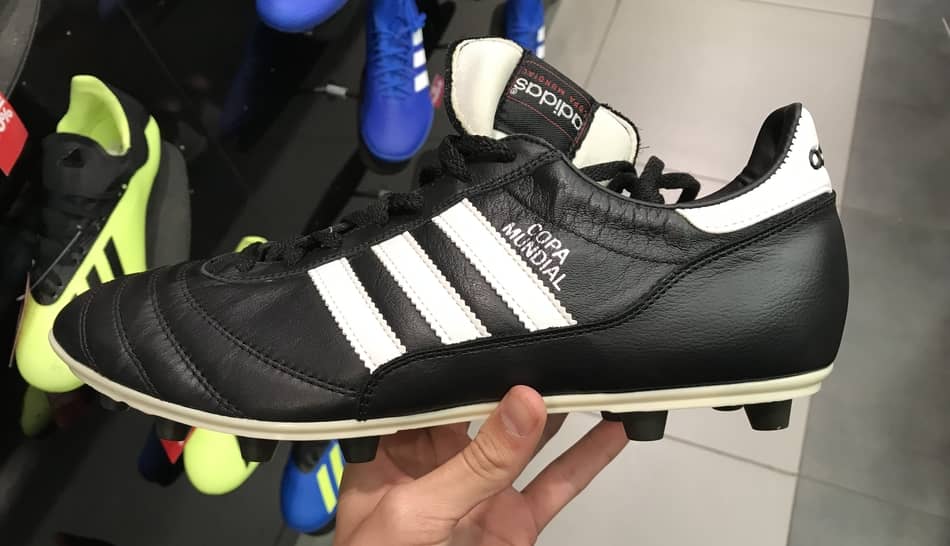
So, when we talk about the advantages of leather cleats, there are plenty. The thing that I like the most of playing in leather soccer cleats is the soft touch on the ball. With leather, you just get a touch that is different from anything else out there. It feels cushioned, precise, smooth, and unique.
Second thing is the capacity leather has to stretch and match the shape of your feet. At the beginning, you’ll have to give more time for the boot to break in, they will probably feel a little tight, but it’s normal. After some time, the leather will stretch and will mold the shape of your feet perfectly. The fit you get with leather boots is unparalleled.
Lastly, leather boots are great for people with wide feet. Because they have the ability to stretch, people with wide feet can comfortably wear a pair of leather soccer cleats without having any pressure points in the foot.
However, not everything is good, there are some disadvantages. The most notable one is that leather needs to be taken care the most out of the three uppers. If you don’t give the right treatment with leather balm, and clean them correctly, the durability of the shoe can seriously be affected.
Another disadvantage is that leather boots are less durable than synthetic boots. After some time, the leather can over-stretch. This doesn’t mean they are not durable, just that they won’t last as long as other uppers. Also, you will need to put in more break-in time, while there are synthetics you can use straight into a game. Consider that leather boots absorb a lot of water too.
Conclusion: Choose the leather upper if you value a lot your comfort and fit. Leather is suitable for responsible people that are willing to take good care of their boots at least once a month. If you do this, you’ll have the best touch soccer cleats can provide. Ideal for people with wide feet.
Knitted boots
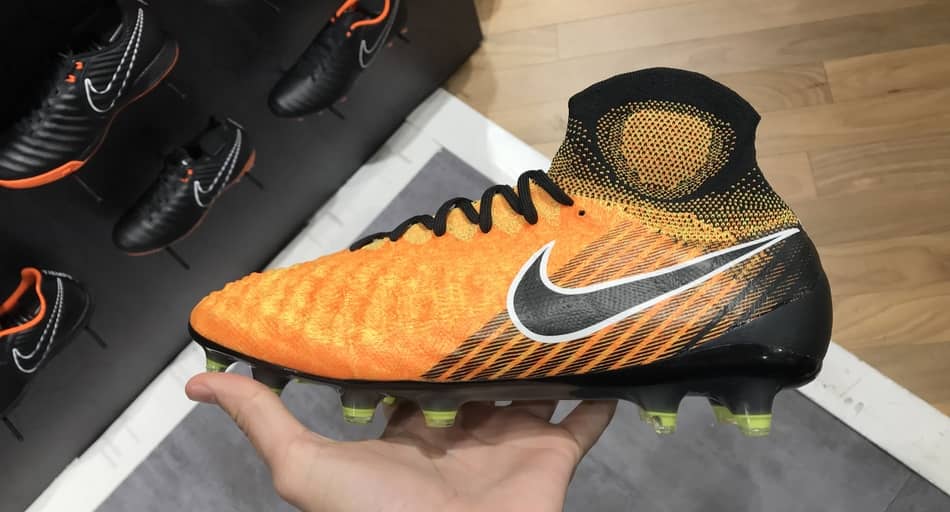
Knitted uppers are a very recent technology in soccer cleats. Yes, its literally soccer cleats made out of knit. The thing is that this knit is super resistant and durable. Normally, in the outside, knitted boots are covered by a silicone material to protect the knit from outside conditions. The best thing about knitted uppers is that they are made to feel as if you were playing with a sock in your feet.
Do they actually do it? In my opinion, not that much. If I’m brutally honest, I don’t find anything significant at the moment that blows my mind about this upper. Which is totally understandable, considering it is a relatively new technology that has a lot of things to improve.
I would recommend to buy boots with this upper if you are willing to try something different or want to have the most modern looking soccer cleats in the pitch.
Synthetic cleats
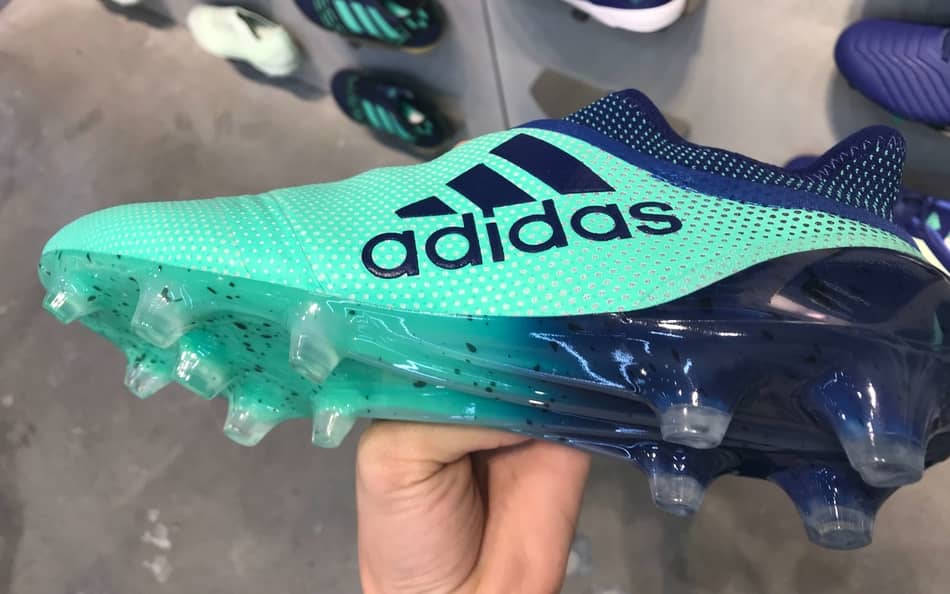
Synthetic cleats are easily the upper of football boots that is bought the most. They offer an alternative to traditional leather that is more durable, doesn’t absorb water, is considerably thinner, and lightweight.
This upper has some time now, and it has become better and better with the years. Today, we find synthetic uppers with incredible quality that are as soft or even softer than a leather upper. This is insane considering that it is an artificial material that doesn’t need to be treated as much as leather, and that doesn’t absorb water.
This type of uppers are normally found in control, speed, and finishing boots, which means that most of the times it will provide a thin, close to barefoot, and lightweight feel, while keeping its durability untouchable. All of these factors make it for a perfect upper for soccer cleats.
However, not all synthetics are the same. As there might be good ones there are also bad ones. Make sure to look up for this information when making the research phase.
Conclusion: If you are not sure which upper to choose, with synthetic you can’t go wrong. It is ideal if you want a thin and lightweight feel, and at the same time a very durable soccer cleat. Just do the research correctly as every synthetic is different in each soccer cleat.
Step 5: What is your budget?

Soccer cleats can be very expensive. Specially top-end football boots that professional players use. During the last years, they’ve become even more expensive. Being said that, I’ve got good news for you, more expensive doesn’t mean better quality. In my opinion, the best soccer cleats out there are not the ones that are the most expensive.
Football boots come in all shapes, sizes, and price. There are two concepts that you need to understand that are: High-end, and Low-end boots or take-down boots.
High-end boots are the soccer cleats that are the most expensive of all. They are the cleats that are meant to be the spotlight of brands, and are exactly the same as the ones professional players use in games. Usually they offer the best playing experience and performance from all the boots in that silo. They are made from the best quality materials. Normally, they cost anywhere between 230 and 350 dollars.
Low-end or take-down boots are cheaper versions of the high-end soccer cleats that represent a budget option for people who aren’t able to buy the high-end cleats. There can be take-down models as cheap as 50 dollars and as expensive as 150 dollars. In a brand’s silo (Mercurial and predator for example) there are 1 or 2 high-end boots with 3 take-down models.
We’ve seen great take-down models from soccer cleats that are VERY similar to the high-end cleats that cost even 100 dollars less than the top-end cleats, and that offer a great quality too. We’ve also seen some horrible take-down models as well. You’ve got to be careful when making your research.
If you have the money to buy high-end soccer cleats then definitely buy a pair because they’ll offer the best playing experience from the market. However, if you don’t have so much money, there is always the option of buying take-down models. If this is your case, I would recommend buying Nike take-downs, usually they offer the best quality.
Trick: Another thing you can do if you’re in a budget, but you still want high-end boots is that you can buy old colorways or past models of the boots you want. Stores tend to lower the price of past shoes because most people don’t want to buy them. However, they have the same or even better quality. It’s like buying an iphone 7 when the newest is the iphone 8, but in this case, newer boots aren’t necessarily better than past boots.
The Ultimate DONT’S (Never do these)
The soccer cleat market is one of the places that has the most misconceptions. People tend to think about things that are totally wrong. The worst thing, is that these misconceptions can significantly keep you away from choosing which is truly the best cleats for you. Here are some of the things to avoid.
Never choose a boot by position
Buying boots by position is easiest the biggest misconception in the whole soccer cleats world. People tend to think that the boot they choose should be dictated according to the position they play. Let me repeat this, THIS IS TOTALLY WRONG.
It is understandable that people think in this way. It is because of brand’s fault, that market their soccer cleats in this way. They want to make people believe that if you play in a specific position, you should buy x pair of boots. For example, normally brands will market that their control boots are exclusively for midfielder, when even a goalkeeper will be okay if he uses a pair of these.
Also, they distribute their cleats by position to their sponsored athletes. Normally, they would give speed boots to the best forwards in the world, control boots to midfielders, and comfort boots to defenders. They do this so that kids and adults associate the boot with a specific position or type of player.
However, let me tell you that there have been players that have refused to use the pair of boots brands have asked them. For example, Neymar was forced to use the Hypervenom silo when he didn’t like it. After some time using it, he changed back to the mercurial silo. Also, Cristiano Ronaldo didn’t like the dynamic fit collar of the “Superfly” silo, so he asked for a low-cut version of the boot, that of course he received.
Position and soccer cleats have absolutely no relationship. If you are a defender and like speed boots you can use them with no problem. If you are an attacker and like comfort boots use them too. It is impossible to say that absolutely all players in one position will have the same preferences.
At the end of the day, the most important thing is that you choose the cleats that fit you better and the ones you feel more satisfied playing in. If you choose boots only by position, then it would be too easy and I wouldn’t even have written this guide.
Absolutely never choose a boot because of a player
One of the worst mistakes most soccer players have done is that we buy a pair of soccer cleats just because our favorite player wears them. If we think about it, it makes no sense for two reasons.
First, because probably the player that is wearing the boots was paid a lot of money to wear them, not because he chose to use them. Second, your favorite player might not have the same preferences you do. Using the boots of your player will make you look cooler, but won’t enhance your performance.
Brands pay the players to use the boots just to trick people like you to buy them. Don’t fall into their game and only buy cleats because you really like the fit and feel comfortable wearing them.
Don’t choose boots because “they look nice”
Another mistake we make is that we buy a boot just because they look nice. I didn’t know that great players were considered to be good because they looked “nice” in the field. Great players are the ones that perform and deliver results expected in the pitch, not players that want to model their cleats. A pair of cleats that looks good doesn’t necessarily fit good on your feet.
Never buy fake soccer cleats
Just don’t do it. A boot that looks like an original branded football boot, but is considerably cheaper is probably fake. Fake football boots are only made for one purpose: to mimic the looks of expensive soccer cleats. They don’t offer anything near the level of quality branded boots offer. Stay away from them if you want a boot that truly performs and that is truly durable.
Make sure to make your research correctly. There will be sellers that will tell you their boots are completely authentic when they aren’t. Make sure to study well the characteristics of authentic soccer cleats and only buy a pair from trusted sellers.
Other Useful Tips
Buying soccer cleats when growing up
One of the worst things I did was buying expensive high-end soccer cleats growing up as a kid and teenager. I had my parents buy 250 dollar cleats being 13 to 16 year old. When we are at this age, our body and feet are growing fast. I remember that they had to buy me a new pair every 6 months because the ones I had bought didn’t fit me any more, they were too small.
Other times, what I did is that I bought cleats overly bigger than my size so they would last for more time. Guess what? Now that my feet finally stopped growing, those cleats don’t fit me because they are too big.
If you are a teenager or a kid that is still growing in his youth, don’t buy super expensive soccer cleats. You will be wasting your money for a shoe that won’t last for more than 6 months. Instead buy cheaper take-down models that offer great quality, and when you are finally an adult or have stopped growing, buy expensive soccer cleats if you want.
Trying on boots if buying online
If you have a soccer store near you that sells the pair of cleats you want to buy online, I would recommend to go and try them on before you buy them in the internet. No matter how much research you do, it will be impossible to exactly tell how the boots will fit in your feets. This is the only way to make sure that the cleats feel according to your preferences.
What is good for a friend might not work for you
We’ve all got friends that buy a new pair of soccer cleats and they tell us how great they are. Other times, an specific boot becomes a trend and we want to buy it because everyone else has it. In this cases, you need to remember that what works for other people, might not work for you as well. That a pair of cleats is trendy doesn’t mean they are the best ones for you.
Common mistakes
Gambling on size
When buying online, you should always remember that there will be boots that don’t fit true to size. Sometimes, they will run half a size smaller or bigger. It is important to include sizing in your research, otherwise you’ll have to return the boots after they arrive and you realize they are not your size.
Naming your boots when you’re not sure
Lately, online stores have included personalization elements for your cleats. In some places you can put your name, a number, your country’s flag, and others. If you do this, the boots are obviously not returnable, so only personalize your boots when you are completely sure they are the best match for you.
Playing with them without trying them on before
As soon as the boots arrive, you have to try them on inside your house to see how they fit and feel. Usually, people want to wear them straight into a match. This is bad for two reasons:
- If you use the boots in a game and you don’t like their fit, they automatically are not returnable because they have already been used.
- Wearing a brand new boot straight into a match can give you blisters, which by the way you can read how to avoid in my “How to avoid blisters” article.
What to do if you have wide feet
It is normal among people with wide feet to have problems when buying soccer cleats because most shoes will be too tight or slim for them. For those of you who have wide feet I have these tips for you when buying soccer cleats:
- Have a tendency to choose leather boots. Usually, leather cleats are wider and the upper has the ability to stretch a lot and match the shape of your feet.
- Stay away from speed boots. Most speed boots are considerably more slim than other cleats, this means that most people with wide feet won’t fit in them. Most comfort, control, and finishing boots will fit people with wide feet. Some times tighter the others, you’ll have to make the call which one works for you.
- If you want to buy synthetic cleats, make sure it is a very soft synthetic that has the ability to stretch.
- Try by all means to try on the boots before buying them. Also, most soccer cleats reviews will say if the boot is good or bad for people with wide feet.
Related Questions
How do you take care of your soccer cleats? Depending if it is synthetic or leather the boots will have different treatments. Leather boots will need a better care than synthetics. Just buy a leather balm and apply it to the upper once a month. With that said, you should always clean your cleats after a match with wipes or water to get the dirt off, no matter if they are synthetic or leather. The care you give to your cleats will determine how durable they will be.
Does weight really matter in soccer cleats? This is a question that depends on everyone’s personal preference. Some people might like the lightweight sensation and other don’t really care. To be honest, most soccer cleats nowadays are considerably light shoes, which is why it’s hard to tell the difference between heavier and lighter cleats on-feet.

